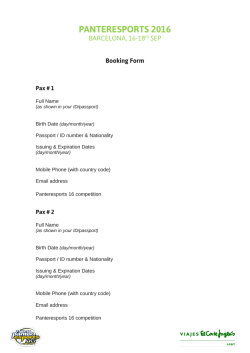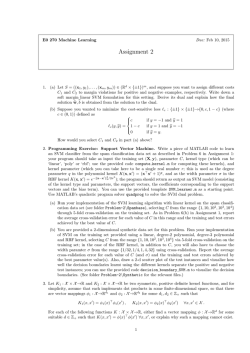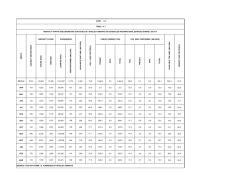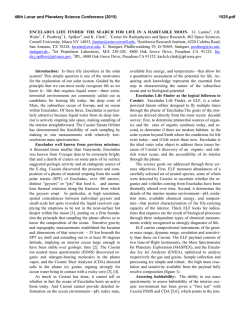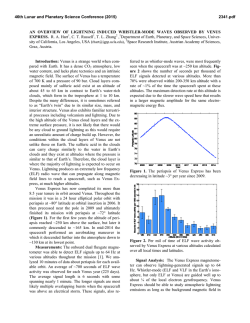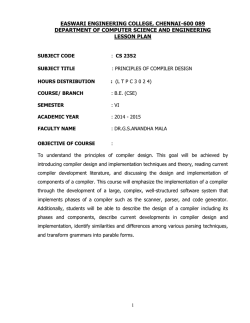
Presentation
"Sections are types, linking is policy"
Intra-Process Memory Protection
for Applications on ARM and
x86: Leveraging the ELF ABI
Sergey Bratus
Julian Bangert
Maxwell Koo
Outline
❖
Why and how to use ELF ABI for policy
❖
Our design of an ELF-backed intra-memory ACLs
❖
❖
Linux x86 prototype
❖
ARM prototype
Case studies:
❖
ICS protocol proxy
❖
OpenSSH policy
Motivation
❖
File-level policies (e.g., SELinux) fail to capture what happens
inside a process (cf. Heartbleed, etc.)
❖
CFI, DFI, SFI, etc. are good mitigations, but they aren't policy:
they don't describe intended operation of code
❖
ELF ABI has plenty of structure to encode intent of a process'
parts: libraries, code & data sections
❖
Already supported by the GCC toolchain!
❖
Policy is easy to create, intuitive for C/C++ programmers
Policy vs mitigations
❖
Both aim to block unintended execution (exploits)
❖
Mitigations attempt to derive intent
❖
❖
Policy attempts to express intent explicitly
❖
❖
E.g., no calls into middles of functions, no returns to noncall sites, etc.
E.g., no execution from data areas, no syscalls beyond a
whitelist, no access to files not properly marked
Policy should be relevant & concise (or else it's ignored)
Policy wish list
❖
Relevance: describe what matters
❖
❖
E.g.: SELinux is a "bag of permissions" on file ops.
Can't describe order of ops, number of ops, memory
accesses, any parts or internals of a process
Brevity: describe only what matters
❖
E.g.: SELinux makes you describe all file ops; you
need tools to compute allowed data flows
What matters?
❖
Composition: a process is no longer "a program"; it's
also many different components & libraries, all in one
space, but with very different purposes & intents
❖
Order of things: a process has phases, which have
different purposes & intents
❖
Exclusive relationships: pieces of code and data have
exclusive relationships by function & intent
❖
"This is my data, only I should be using it"
An inspiration: ELF RTLD
John Levine, "Linkers & loaders"
An inspiration: PaX/Grsec UDEREF
❖
UDEREF guards code from accessing the data it wasn't
meant to access
❖ "Privilege Rings" are too about code/data relationships
User
Poisoned Data
Args
Call gate
Kernel
Checks
Syscall
Driver
"Some thoughts on security after ten years
of qmail", D.J. Bernstein, 2007
❖ Used process isolation as security boundaries
❖ Split functionality into many per-process pieces
❖ Enforced explicit data flow via process isolation
❖ Avoided in-process parsing
❖ Least privilege was a distraction, but isolation worked
http://cr.yp.to/qmail/qmailsec-20071101.pdf
Process phases
❖
"Phase" ~ code unit ~ EIP range ~ memory section
Access relationships are key to
programmer intent
❖
Unit semantics ~ Explicit data flows (cf. qmail)
Intent-level semantics
❖
❖
"The gostak distims the doshes" -- Andrew Ingraham, 1903
❖
Non-dictionary words, English grammar
❖
Semantics == relationships between terms
Relationships between code & data sections reflect
their intent, often uniquely
"Sections are types, linking is policy"
❖
The idea of a type is "objects with common operations"
❖
❖
For data sections, their dedicated code sections are their
operations
❖
❖
Methods of a class in OOP, typeclasses in FP, etc.
It's dual: data accessed by code tells much about code
Linkers collect similar sections into contiguous pieces
❖
Linker maps are the closest we have to intent
descriptions of binary objects in process space!
Motivating Example
Example policies
❖
Web application decompresses a PNG file
❖
Mental model
.PNG file
libpng
Bitmap
What attackers see
private key
no-longer-private
key
malicious .PNG
.PNG file
libpng
w/ bugs
Bitmap with
leaked data
Or
Bitmap overwrites
critical data
Authorized keys
.PNG file, with
exploit
malicious .PNG
libpng
w/ bugs
Mapping it into the ABI
libssl .data
•
Easy to introduce new sections
•
Each code segment can get
different permissions
•
Only libssl.text can access
libssl.data
•
libpng.text can only access
libpng.input and libpng.output
•
And libpng.input can only be
read by libpng.
private key
libpng .input
malicious .PNG
libpng .output
bitmap
Back to our example
SSL initialization
RW
SSL
R
SSL keys
libpng
RW
R
Input buffer
W
app logic
RW
Output
buffer
Enforcing
❖
Modern OS loaders discard section information
❖
New architecture:
❖
'Unforgetful loader' preserves section identity after
loading
❖
Enforcement scheme for intent-level semantics
❖
Better tools to capture semantics in ABI
ELF sections
ELF consists of sections:
❖ Code
❖ Data (RW/RO)
❖ GOT/PLT jump tables for
dynamic linking
❖ Metadata: Symbols, ...
❖ Can be controlled from C:
__section__(section_name)
❖ Flexible mechanism
❖ ~30 sections in typical file
.text
libpng.so
.init
...
libc.o
program.o
.text
.data
.text
.data
Sections turn into segments
Linker combines sections & groups them into segments:
libpng.o
.text
.text(program.o)
.data
.text(libc)
...
libc.o
program.o
R_X .text(libpng)
.text
.rodata
.data
.data(program.o)
.text
.rodata
.data(libc)
RW_ .data(libc)
.bss (heap)
Only RWX bits enforced
Two loaders
❖
❖
❖
Static linking:
❖
kernel (binfmt_elf.{c,ko}) reads segments
❖
calls mmap() for each segment
❖
jumps to entry point
Dynamic linking
❖
Kernel loads ld.so (as in the above)
❖
ld.so parses ELF file again (bugs happen here)
❖
ld.so opens shared libraries, mmaps and maintains .PLT/.GOT tables
One mmap() call per segment
What the kernel does:
❖
Kernel:
❖
❖
task_struct for each thread
❖
registers, execution context => state
❖
pid, uid, capabilities => identity of the process
mm_struct for address space
task_struct thread_1
mm_struct
task_struct thread_2
task_struct thread_1
task_struct thread_2
vm_area_struct
mmap
mm_struct
0x40000
.text(program.o)
.text(libc)
.text(libpng)
.rodata
0x80000
.data(program.o)
.data(libc)
Linked list of vm_area_structs
Points to file system or anonymous
memory structure
.data(libpng)
.bss (heap)
FS
./foo
task_struct thread_1
task_struct thread_2
vm_area_struct
mmap
mm_struct
mm_rb
RB-tree
0x40000
.text(program.o)
.text(libc)
.text(libpng)
.rodata
0x80000
.data(program.o)
.data(libc)
RB tree for faster lookups
LRU cache for even faster lookups
.data(libpng)
.bss (heap)
FS
./foo
What the CPU sees
mm_struct/CPU CR3
PGD
pud_t*[512]
PUD
pmd_t*[512]
pmd_t*[512]
pmd_t*[512]
PMD
pte_t*[512]
pte_t*[512]
pmd_t*[512]
PTE
pte_t[512]
pte[512]
pte_t[512]
physical address + flag
All three structures have to be kept in sync
Caching
❖
Walking these structures on every memory access
would be prohibitively slow
❖
TLBs cache every level of this hierarchy
❖
Originally invalidated on reload
❖
Tagged TLBs (PCID on intel). ELFbac also had the first
PCID patch for linux. Transparent on AMD
Caches enforce policy!
❖
NX bit is seen as a mere mitigation
❖
Actually it is policy that express intent
❖
First implementations of NX used cache state (split TLB)
meant for performance to add semantics
❖
ELFbac does the same with TLBs and PCID
It's all about caching
❖
Each VM system layer is a cache
❖
And performs checks
❖
Checks get semantically less expressive as you get
closer to hardware
❖
ELFbac adds another layer of per-phase caching
❖
Allows us to enforce a semantically rich policy
Example: Page faults
❖
If the page table lookup fails, CPU calls the kernel
❖
Kernel looks for the vm_area_struct (rb_tree)
❖
Check: If not present, SIGSEGV
❖
Fill in page table, with added semantics
❖
Swap-in
❖
Copy-on-write
❖
Grow stacks
ELFbac execution model
❖
Old n-1 relationship:
❖
❖
New n-m relationship:
❖
❖
task_struct(n threads) <-> mm_struct(1 process)
task_struct(n threads) <-> mm_struct(m ELFbac states)
A lot of kernel code would have to change to update m
copies
Caching as a solution
❖
ElfBAC states are subsets of the base address space
❖
Base address space still represented by mm
❖
Squint enough, and a subset is like a cache
❖
Only need invalidation instead of mutation
❖
Caches already have to be invalidated (TLB)
❖
Linux: mm_notifier plug-in API(virtualization)
ELFbac page fault handler
❖
If the access would fault on the base page tables
❖
❖
Fall back to the old page fault handler
Look up the address in ELFbac policy
❖
Move process to new phase if necessary
❖
Otherwise copy page table entry to allow future
accesses
What each part sees:
Rest of kernel :
task_struct thread_1
task_struct thread_2
base
mm_struct
ELFbac:
elfbac policy
mm_struct
Authenticate
mm_struct
ProcessInput
page tables
page tables
CPU
vm_area_struct
page tables
Porting to embedded ARM
❖
Focused on compartmentalizing ELF binaries under static linking
❖
❖
Dynamic linking case supportable by creating an ELFbac-aware
ld.so, left to future work
Policies generated from a JSON descriptor file
❖
tool produces both the linker script and the binary policy
❖
Binary policy is packed into a special segment, loaded by the kernel
during ELF loading time
❖
Modifications to the page fault handler enforce the policy at runtime,
verifying memory accesses and state transitions
❖
ARM ASIDs (tagged TLB) reduce overhead between state transitions
Case Studies
Basic example: isolating a parser
Grammar&
Spec&
Input&
Recognizer&
for&input&
language&
Reject&&
invalid&
inputs&
Processing:&&
malloc()&
memcopy()&
+,&*,&9,&/,&…&&
Accept&valid/expected&inputs,&
call&semanFc&acFons&
ELFbac for SCADA/ICS
❖
DNP3 is a complex ICS protocol; prone to parser errors
❖
❖
❖
S4x14: "Robus Master Serial Killer", Crain & Sistrunk
Only a small subset of the protocol is used on any single
device. Whitelisting this syntax is natural.
❖
A filtering proxy is a DNP3 device's best friend
❖
"Exhaustive syntactic inspection": langsec.org/dnp3/
ELFbac policy: isolate the parser from the rest of the app
Parser isolation
❖
Raw data is (likely) poison; parsing code is the riskiest
part of the app & its only defense
❖
Parser must be separated from the rest of the code
❖
❖
No other section touches raw input
❖
Parser touches no memory outside of its output area,
where it outputs checked, well-typed objects
Input => Parser => Well-typed data => Processing code
ICS proxy policy at a glance
Our ARM target
ELFbac & Grsec/PaX for ARM
❖
We worked with the Grsecurity to integrate ELFbac on
ARM with Grsecurity for ICS hardening:
❖
Cohesive set of protections for ICS systems on ARM
❖
❖
❖
PAX_KERNEXEC, PAX_UDEREF, PAX_USERCOPY, PAX_CONSTIFY,
PAX_PAGEEXEC, PAX_ASLR, and PAX_MPROTECT
Available from https://grsecurity.net/ics.php
ELFbac + Grsecurity ICS tested with our DNP3 proxy on
a common industrial computer Moxa UC-8100, ARM v7
(Cortex-A8)
OpenSSH policy
❖
OpenSSH attacked via crafted inputs
❖
❖
OpenSSH introduced the original privilege drop as a
policy primitive
❖
❖
GOBBLES pre-auth RCE 2002 -- CVE-2016-077{7,8}
"If the process asks for a privileged op after this point,
it's no longer trustworthy; kill it"
But access to (a) non-raw data for a parser (b) raw data
beyond the parser is also privilege!
ELFbac for OpenSSH
❖
Policies for both the OpenSSH client and server
❖
Isolate portions of OpenSSH responsible for crypto/key
management from those responsible for processing & parsing
packets
❖
Create separate sections for sensitive data blobs, allowing for
finer-grained access control
❖
Control access to libraries used by OpenSSH based on where used
❖
Prevent direct leaking of sensitive data like private keys from, e.g.,
CVE-2016-0777 (roaming vuln)
❖
Separate heaps for dynamic allocations, with specific access
permissions across process phase boundaries
OpenSSH policy at a glance
Application design considerations
❖
"Separating concerns" is good engineering, but has limited
security pay-offs
❖
❖
❖
All concerns still live in the same address space
Keeping separate heaps in a process has limited returns
❖
Proximity obstacles to overflows/massaging, but still the
same address space, accessible by all code
❖
Mitigation, not policy
With ELFbac, keeping marked, separating heaps becomes
policy: clear intent, enforced w.r.t. code units
ELFbac is a design style
❖
"Who cares? That's not how code gets written"
❖
Availability of enforcement mechanisms reshapes
programming practice
❖
❖
C++ took over the world by making contracts (e.g.,
encapsulation) enforceable (weakly, at compile time)
❖
Non-enforceable designs are harder to adopt & check
Only enforceable separation matters
Performance & TODOs
Performance overheads (x86)
❖
NGINX benchmarked with a policy isolating all libraries from the
main process:
❖
Best case: around ~5% (AMD Opteron Piledriver)
❖
❖
worst case: ~30% on some Intel platforms
❖
Too many state transitions on the hot path
❖
Policy must be adapted to the application structure
Average ~15% when running on KVM
❖
KVM already incurs performance costs
❖
KVM optimizes virtual memory handling
Drawbacks and TODOs
❖
Significant performance tuning still outstanding
❖
Implement an ELFbac-aware malloc
❖
Integration with system call policy mechanisms (e.g.
Capsicum)
❖
Provide rich policies for many standard libraries
❖
ELFbac is not a mitigation, it's a way to design
policies and resilient applications
Binary Rewriting Tools
❖
Store policy in the ELF file
❖
Loader sends it to the kernel with a new syscall
❖
Adding a policy requires binary rewriting
❖
Made our own tool: Mithril, currently only implemented for ELF
❖
Translates binaries into a canonical form that is less context-dependent and
can be easily modified
❖
Tested on the entire Debian x86_64 archive, producing a bootable system
❖
~25GB of packages
Takeaway
❖
Per-process bags of permission are no longer a suitable
basis for policy
❖
Instead, ABI-level memory objects at process runtime are
the sweet spot for security policy
❖
Modern ABIs provide enough granularity to capture
programmers intent w.r.t. code and data units
❖
Intent-level semantics compatible with ABI, standard
build/binary tool chains
Policy Granularity: ABI is the Sweet Spot
ABI
Thank you
ABI
❖
http://elfbac.org/
❖
https://github.com/sergeybratus/elfbac-arm/
© Copyright 2026
